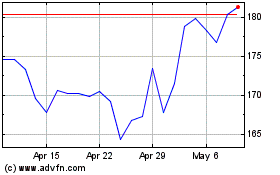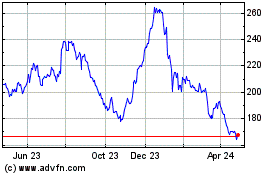Boeing Profit Falls as Jet Charges Mount -- 4th Update
April 27 2016 - 6:46PM
Dow Jones News
By Jon Ostrower
Boeing Co. delivered a lower profit for the first quarter and
revealed more costly stumbles with its newest military
aircraft.
Executives said its production and profit targets for the year
remained on track, which reassured investors. But the latest
charges, including a $243 million pretax charge on its new Air
Force refueling tanker, suggest the world's largest aerospace
company hasn't solved its problems as it transitions to aircraft
that will be the foundation for its future profits.
The charge on the tanker adds to the $1.26 billion in overruns
associated with the tanker's development. The tanker charge and a
$70 million charge on its biggest jetliner, the 747-8 jumbo,
weighed down its profit margin at its commercial jet unit.
"While we don't like taking a charge, we're confident that we're
doing the right things here," said Dennis Muilenburg, Boeing's
chief executive. "That is an intentional investment we're making to
keep the program on schedule."
The company has struggled with development delays and the
resulting high cost of production of new military and commercial
jets over the past decade, which have diluted the benefits of an
unprecedented surge in orders and deliveries of passenger
planes.
The company for the first time since 2011 missed analysts'
profit expectations, according to FactSet, absorbing the 24 cent
per share charge to its earnings which fell to $1.74 from
$1.97.
Despite the earnings decline and miss, the company reiterated
its full-year guidance, bought back $3.5 billion in shares, and
stuck to its long-term expectations for positive cash generation on
its flagship 787 Dreamliner. The quarterly buyback was the biggest
since 2000, the farthest back it has available records, according
to the company.
That helped Boeing shares close up 2.9% at $137.08, their
highest level since early January.
Boeing has delivered strong earnings in recent years, driven
largely by an insatiable demand for commercial jets. But the
company also faces long-term challenges, including pressure on its
jet prices and declining market share against European and Canadian
rivals for its highly-lucrative single-aisle 737 jetliners.
Mr. Muilenburg reiterated that the company is scaling back its
workforce this year in a bid to reduce its internal costs. The
company so far has said it plans to cut 4,500 positions through
attrition and voluntary layoffs by midyear to boost
productivity.
Boeing is capitalizing on the sustained expansion in global
commercial aviation, as airlines continue to replace and grow their
fleets.
Mr. Muilenburg Wednesday said customers are changing existing
jet orders -- canceling or deferring deals -- at a far slower pace
than in the past, with just 1% of its backlog affected. He said
that even if cancellations were to rise, its planned production
increases would remain unchanged.
Earlier this year, Boeing said it would deliver 740 to 745
commercial aircraft in 2016, down from the record-high 762 last
year, as it produced aerial tankers and updated single-aisle jets
that won't be delivered until 2017. In the latest quarter, the
company delivered 176 commercial planes, eight fewer than a year
earlier, prompting a 6.4% revenue drop to $14.4 billion.
Boeing faces a cash generation challenge in the years to come as
transitions to updated models of its most lucrative jets, the
long-range 777 and single-aisle 737. Boeing will build roughly 16
fewer 777s annually starting in 2017 and it is in the early phases
of production of its revised 737.
The company has also sought to calm long-term investor and
analyst concerns about its nearly $29 billion in deferred costs on
its 787 Dreamliner that it plans to recover over a total of 1,300
deliveries. Boeing's Dreamliner is considered profitable through
its approved accounting method which spreads its costs out over
roughly a decade of production.
Boeing has delivered roughly 390 Dreamliners since late 2011,
each at an average of a more than $70 million loss.
Boeing is striving to expand the revenue it generates from its
aftermarket parts and services business. Mr. Muilenburg said the
company anticipates 5% to 10% growth rates in its commercial and
defense services and spare parts business in the coming years.
The company said higher deliveries of military aircraft helped
offset the dip in commercial jet deliveries. Revenue from military
aircraft rose by about a third, thanks to higher F-15 fighter jets
and C-17 cargo hauler deliveries.
Write to Jon Ostrower at jon.ostrower@wsj.com
(END) Dow Jones Newswires
April 27, 2016 18:31 ET (22:31 GMT)
Copyright (c) 2016 Dow Jones & Company, Inc.
Boeing (NYSE:BA)
Historical Stock Chart
From Mar 2024 to Apr 2024

Boeing (NYSE:BA)
Historical Stock Chart
From Apr 2023 to Apr 2024
